Analytical framework for BS-seq data comparison and visualization
Project description
BismarkPlot
Analytical framework for BS-seq data comparison and visualization.
See the docs: https://shitohana.github.io/BismarkPlot
Right now only coverage2cytosine input is supported, but support for other input types will be added soon.
Installation
pip install bismarkplot
Console usage
You can use bismarkplot either as python library or directly from console after installing it.
Console options:
bismarkplot-metagene- methylation density visualizing tool.bismarkplot-chrs- chromosome methylation levels visualizing tool.
bismarkplot-metagene
usage: BismarkPlot. [-h] [-o NAME] [--dir DIR] [-g GENOME] [-r {gene,exon,tss,tes}] [-b BATCH] [-c CORES] [-f FLENGTH] [-u UWINDOWS] [-d DWINDOWS] [-m MLENGTH] [-w GWINDOWS] [--line] [--heatmap]
[--box] [--violin] [-S SMOOTH] [-L LABELS [LABELS ...]] [-C CONFIDENCE] [-H VRESOLUTION] [-V HRESOLUTION] [--dpi DPI] [-F {png,pdf,svg}]
filename [filename ...]
Metagene visualizing tool.
positional arguments:
filename path to bismark methylation_extractor files
optional arguments:
-h, --help show this help message and exit
-o NAME, --out NAME output base name (default: plot)
--dir DIR output dir (default: /Users/shitohana/PycharmProjects/BismarkPlot_test)
-g GENOME, --genome GENOME
path to GFF genome file (default: None)
-r {gene,exon,tss,tes}, --region {gene,exon,tss,tes}
path to GFF genome file (default: gene)
-b BATCH, --batch BATCH
number of rows to be read from bismark file by batch (default: 1000000)
-c CORES, --cores CORES
number of cores to use (default: None)
-f FLENGTH, --flength FLENGTH
length in bp of flank regions (default: 2000)
-u UWINDOWS, --uwindows UWINDOWS
number of windows for upstream (default: 50)
-d DWINDOWS, --dwindows DWINDOWS
number of windows for downstream (default: 50)
-m MLENGTH, --mlength MLENGTH
minimal length in bp of gene (default: 4000)
-w GWINDOWS, --gwindows GWINDOWS
number of windows for genes (default: 100)
--line line-plot enabled (default: False)
--heatmap heat-map enabled (default: False)
--box box-plot enabled (default: False)
--violin violin-plot enabled (default: False)
-S SMOOTH, --smooth SMOOTH
windows for smoothing (default: 10)
-L LABELS [LABELS ...], --labels LABELS [LABELS ...]
labels for plots (default: None)
-C CONFIDENCE, --confidence CONFIDENCE
probability for confidence bands for line-plot. 0 if disabled (default: 0)
-H VRESOLUTION vertical resolution for heat-map (default: 100)
-V HRESOLUTION vertical resolution for heat-map (default: 100)
--dpi DPI dpi of output plot (default: 200)
-F {png,pdf,svg}, --format {png,pdf,svg}
format of output plots (default: pdf)
Example:
bismarkplot-metagene -g path/to/genome.gff -r gene -f 2000 -m 4000 -u 500 -d 500 -w 1000 -b 1000000 --line --heatmap --box --violin --dpi 200 -f pdf -S 50 report1.txt report2.txt report3.txt report4.txt
bismarkplot-chrs
usage: BismarkPlot [-h] [-o NAME] [-d DIR] [-b N] [-c CORES] [-w N] [-m N] [-S FLOAT] [-F {png,pdf,svg}] [--dpi DPI] path/to/txt
Chromosome methylation levels visualization.
positional arguments:
path/to/txt path to bismark methylation_extractor file
optional arguments:
-h, --help show this help message and exit
-o NAME, --out NAME output base name (default: plot)
-d DIR, --dir DIR output dir (default: /Users/shitohana/PycharmProjects/BismarkPlot_test)
-b N, --batch N number of rows to be read from bismark file by batch (default: 1000000)
-c CORES, --cores CORES
number of cores to use (default: None)
-w N, --wlength N number of windows for chromosome (default: 100000)
-m N, --mlength N minimum chromosome length (default: 1000000)
-S FLOAT, --smooth FLOAT
windows for smoothing (0 - no smoothing, 1 - straight line (default: 50)
-F {png,pdf,svg}, --fmt {png,pdf,svg}
format of output plots (default: pdf)
--dpi DPI dpi of output plot (default: 200)
Example:
bismarkplot-chrs -b 10000000 -w 10000 -m 1000000 -s 10 -f pdf path/to/CX_report.txt
Python
BismarkPlot provides a large variety of function for manipulating with cytosine methylation data.
Metagene
Below we will show the basic BismarkPlot workflow.
Single sample
import bismarkplot
# Firstly, we need to read the regions annotation (e.g. reference genome .gff)
genome = bismarkplot.Genome.from_gff("path/to/genome.gff")
# Next we need to filter regions of interest from the genome
genes = genome.gene_body(min_length=4000, flank_length=2000)
# Now we need to calculate metagene data
metagene = bismarkplot.Metagene.from_file(
file = "path/to/CX_report.txt",
genome=genes, # filtered regions
upstream_windows = 500,
gene_windows = 1000,
downstream_windows = 500,
batch_size= 10**7 # number of lines to be read simultaneously
)
# Our metagene contains all methylation contexts and both strands, so we need to filter it (as in dplyr)
filtered = metagene.filter(context = "CG", strand = "+")
# We are ready to plot
lp = filtered.line_plot() # line plot data
lp.draw().savefig("path/to/lp.pdf") # matplotlib.Figure
hm = filtered.heat_map(ncol=200, nrow=200)
hm.draw().savefig("path/to/hm.pdf") # matplotlib.Figure
Output for Brachypodium distachyon:
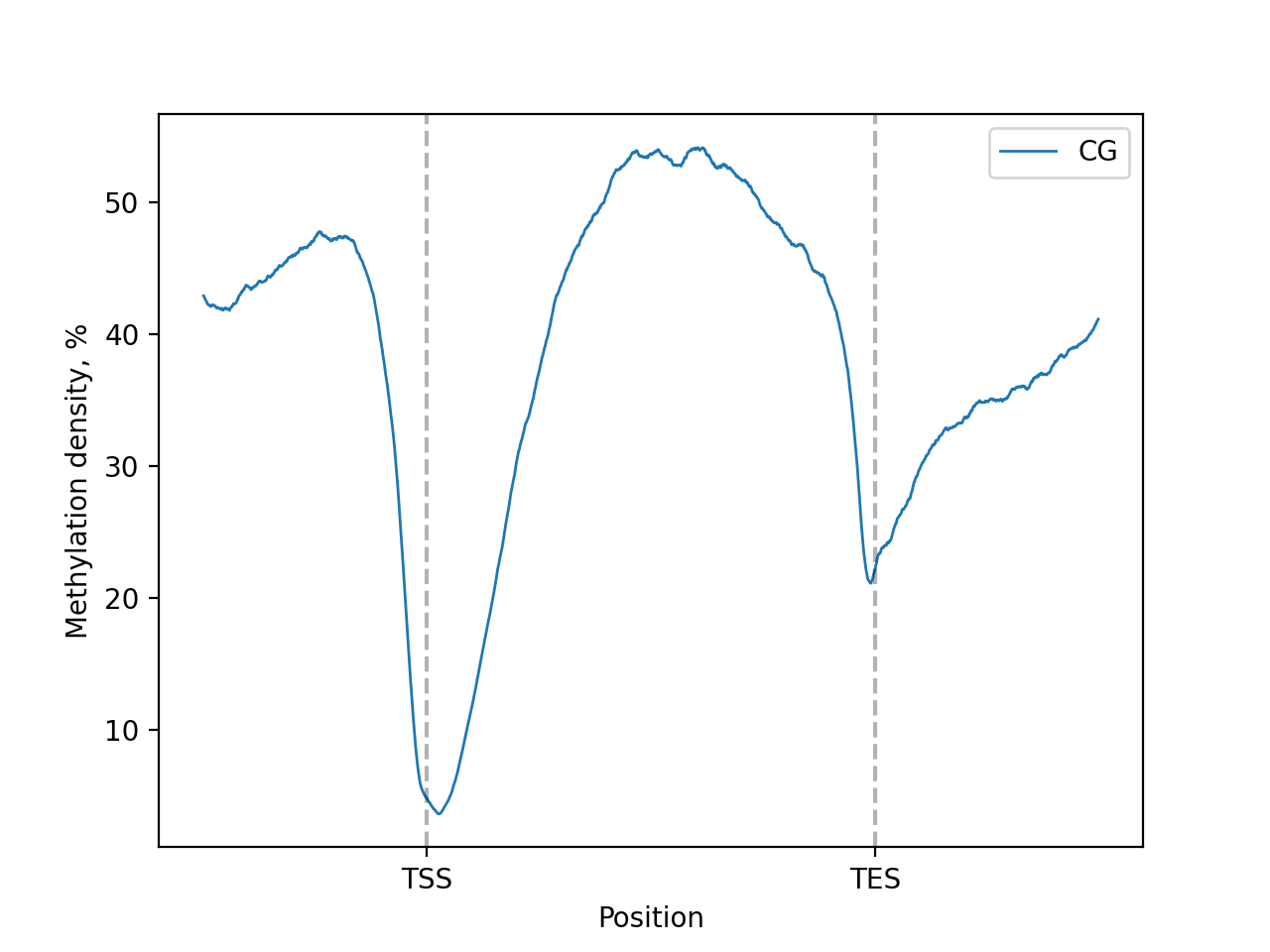
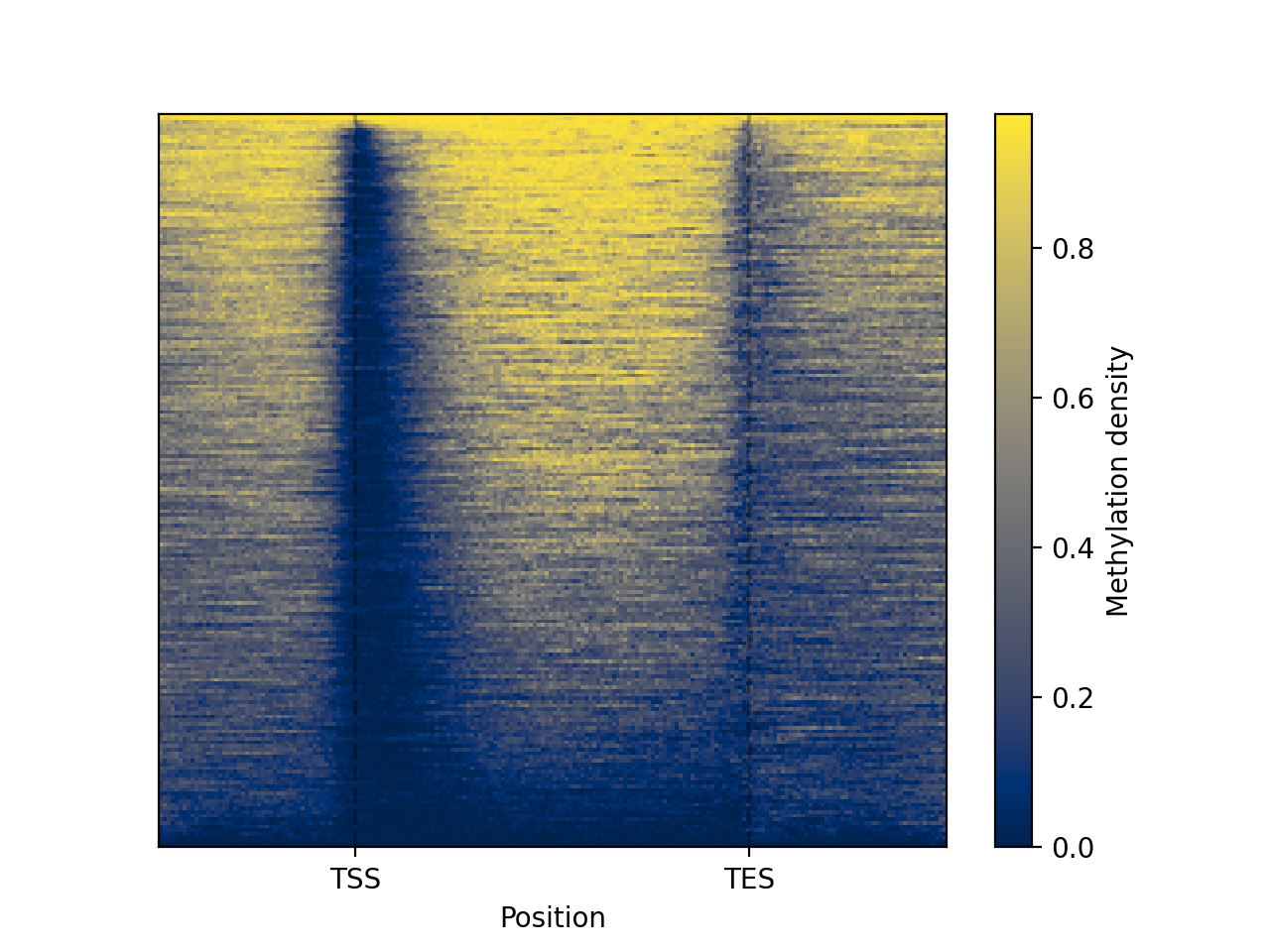
If metagene is not filtered by context, all available contexts will be plotted:
filtered_by_strand = metagene.filter(strand == "+")
lp = filtered_by_strand.line_plot()
lp.draw()
Output for Brachypodium distachyon:

Confidence bands can be visualized via setting the confidence parameter in LinePlot.draw()
lp.draw(confidence=.95)
Output for Brachypodium distachyon:
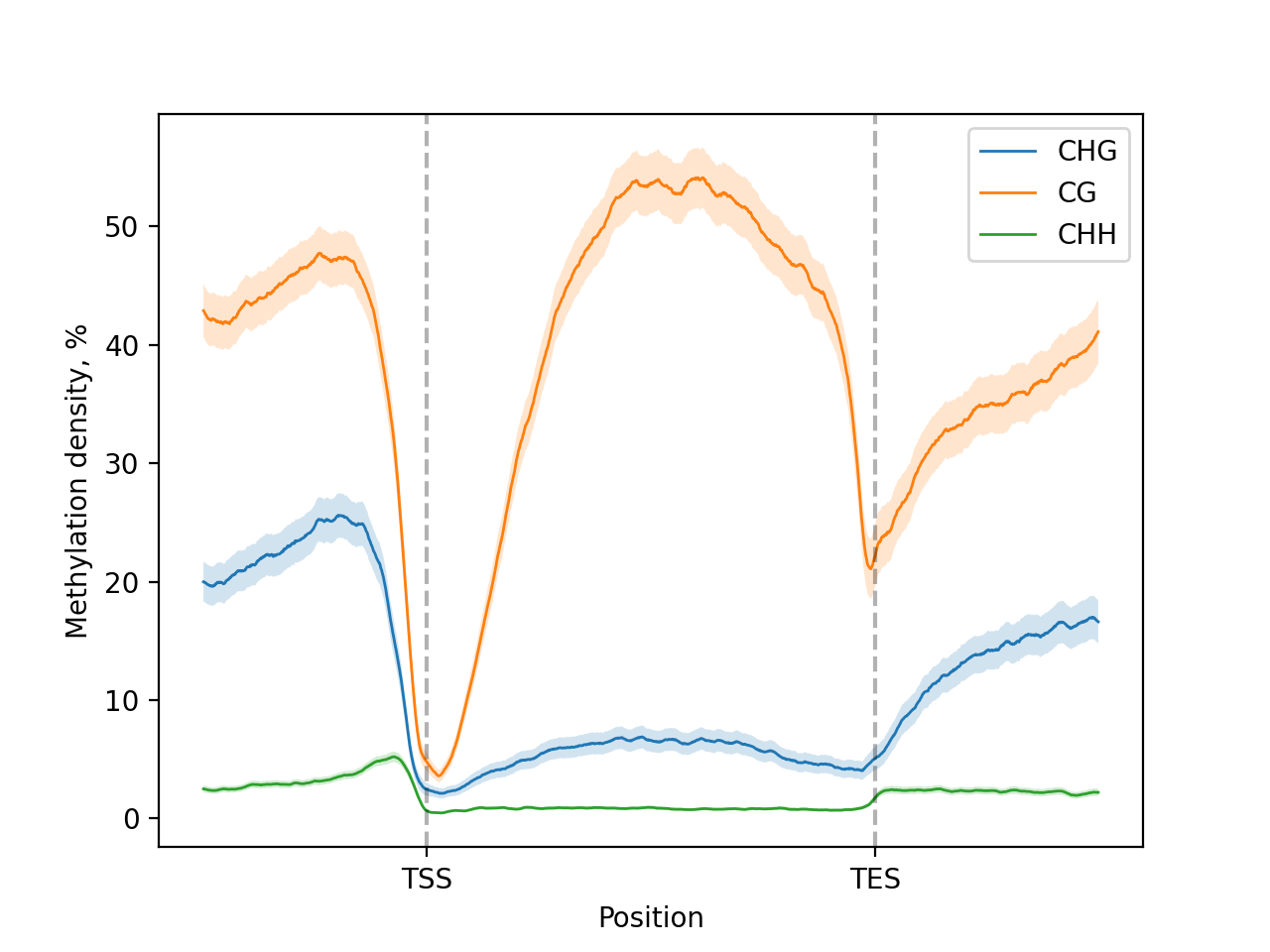
Heat-map clusterisation
Genes can be clustered to minimize distances between them before plotting heat-map. This can be useful for capturing overall methylation patterns in sample. This operation is very time consuming. It is advised to set small number of windows (< 50).
metagene = bismarkplot.Metagene.from_file(
file = "path/to/CX_report.txt",
genome=genes, # filtered regions
upstream_windows = 5, gene_windows = 10, downstream_windows = 5,
)
clustered = metagene.clustering(
count_threshold=5, # Minimum counts per window
dist_method="euclidean", # See scipy.spatial.distance.pdist
clust_method="average" # See scipy.cluster.hierarchy.linkage
)
# Heatmap with optimized distances between genes will be drawn
clustered.draw().savefig("path/to/clustered_hm.pdf")
Output for Brachypodium distachyon - CHG
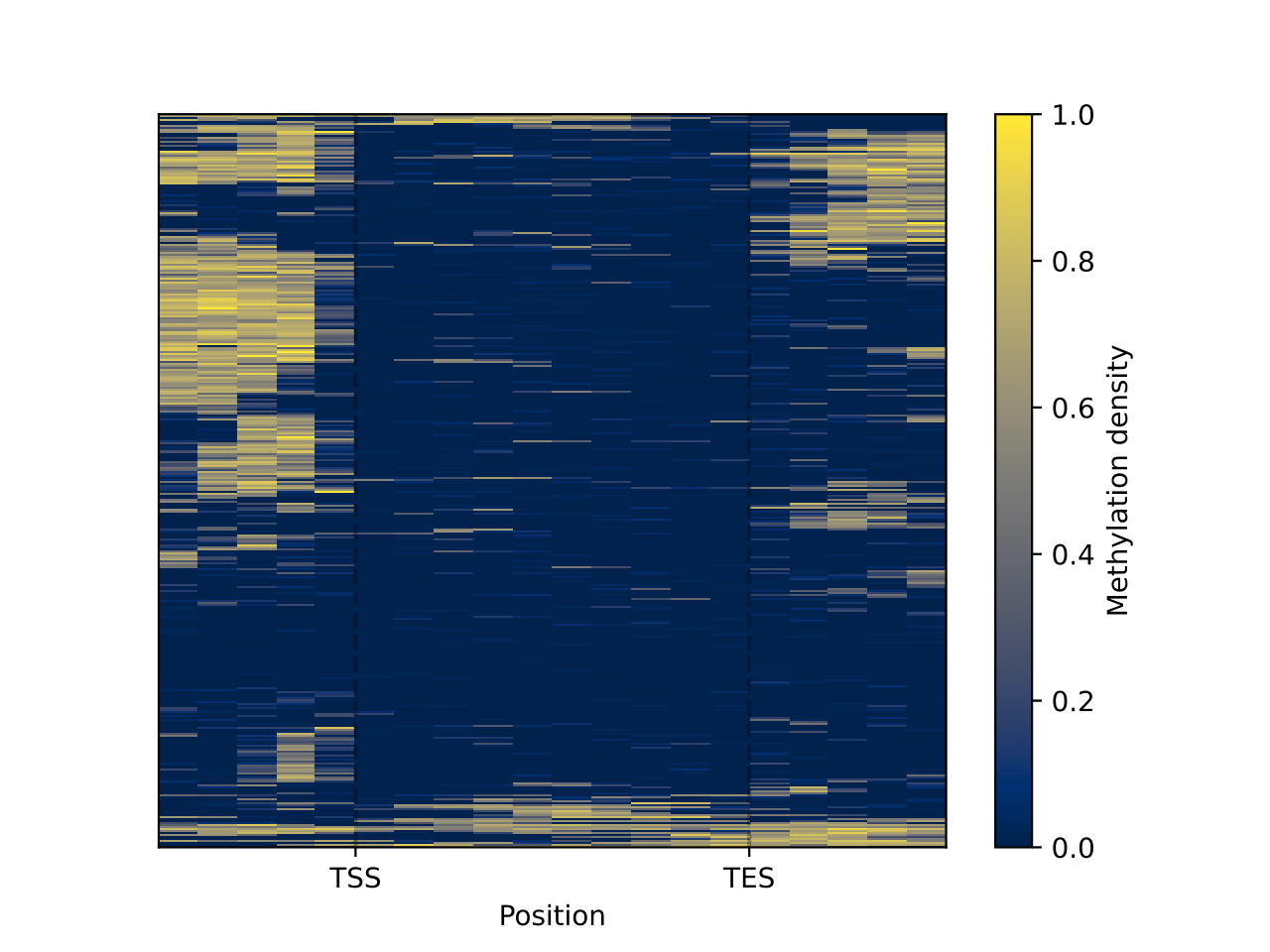
Genes dynamicTreeCut
To shrink clustered heat-map and capture main patterns genes can be split into modules using dynamicTreeCut algorithm by Peter Langfelder and Bin Zhang. Then genes can be plotted as heat-map as previous example:
# Parameters are the same as for cutreeHybrid (see dynamicTreeCut)
modules = clustered.modules(deepSplit = 1)
modules.draw().savefig("path/to/modules_hm.pdf")
Output for Brachypodium distachyon - CHG
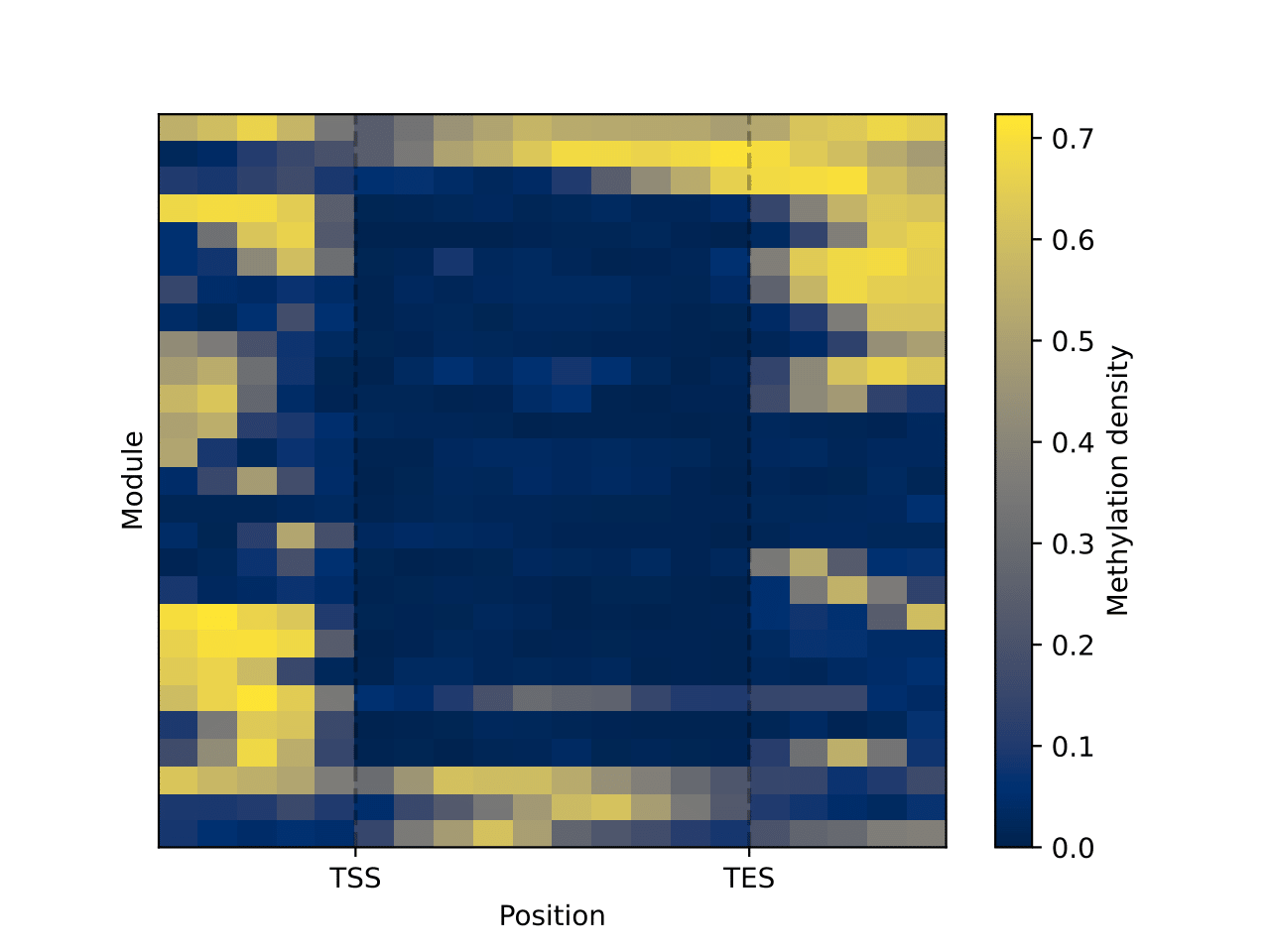
Smoothing the line plot
Smoothing is very useful, when input signal is very weak (e.g. mammalian non-CpG contexts)
# mouse CHG methylation example
filtered = metagene.filter(context = "CHG", strand = "+")
lp.draw(smooth = 0).savefig("path/to/lp.pdf") # no smooth
lp.draw(smooth = 50).savefig("path/to/lp.pdf") # smoothed with window length = 50
Output for Mus musculus:
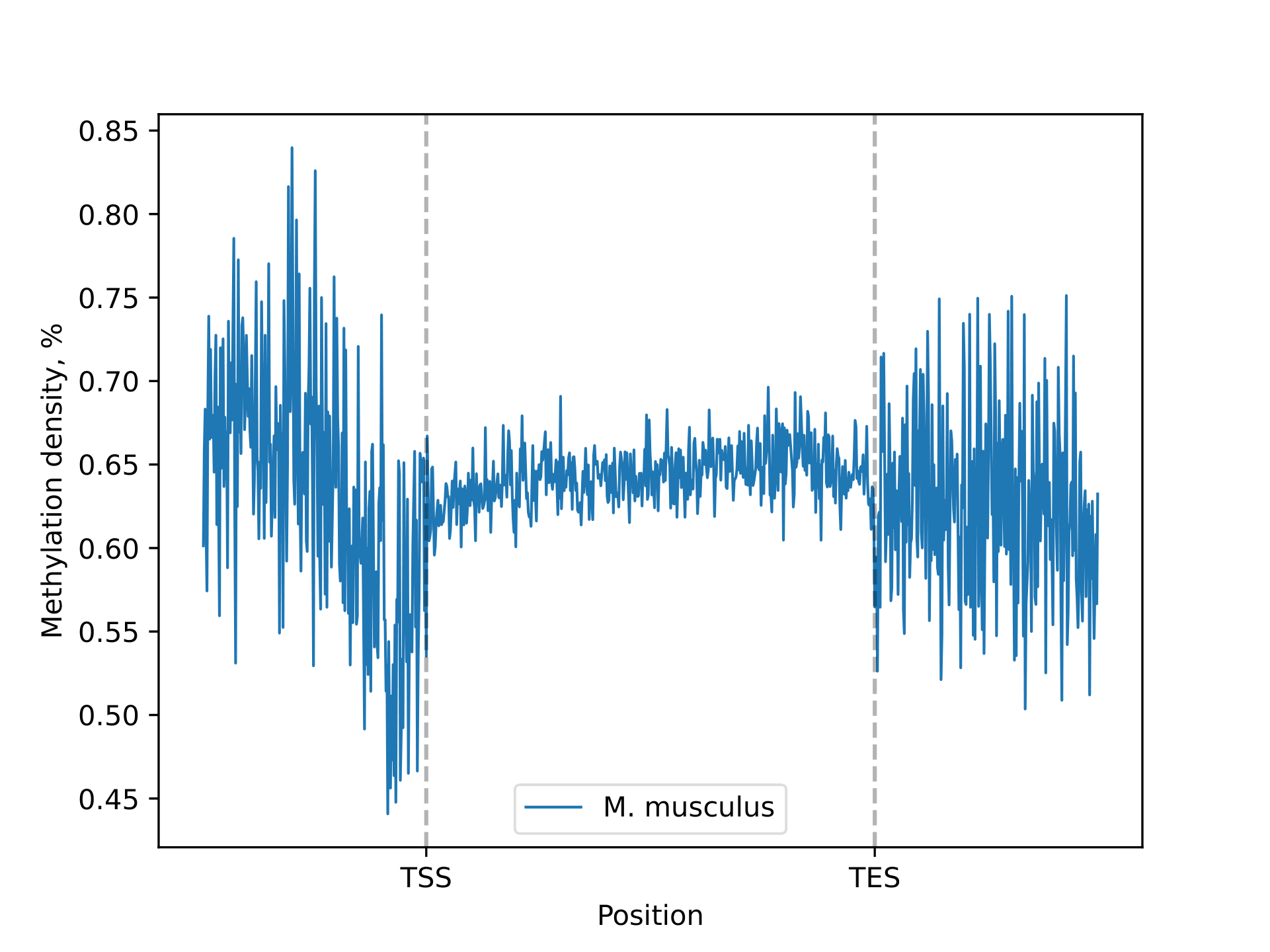
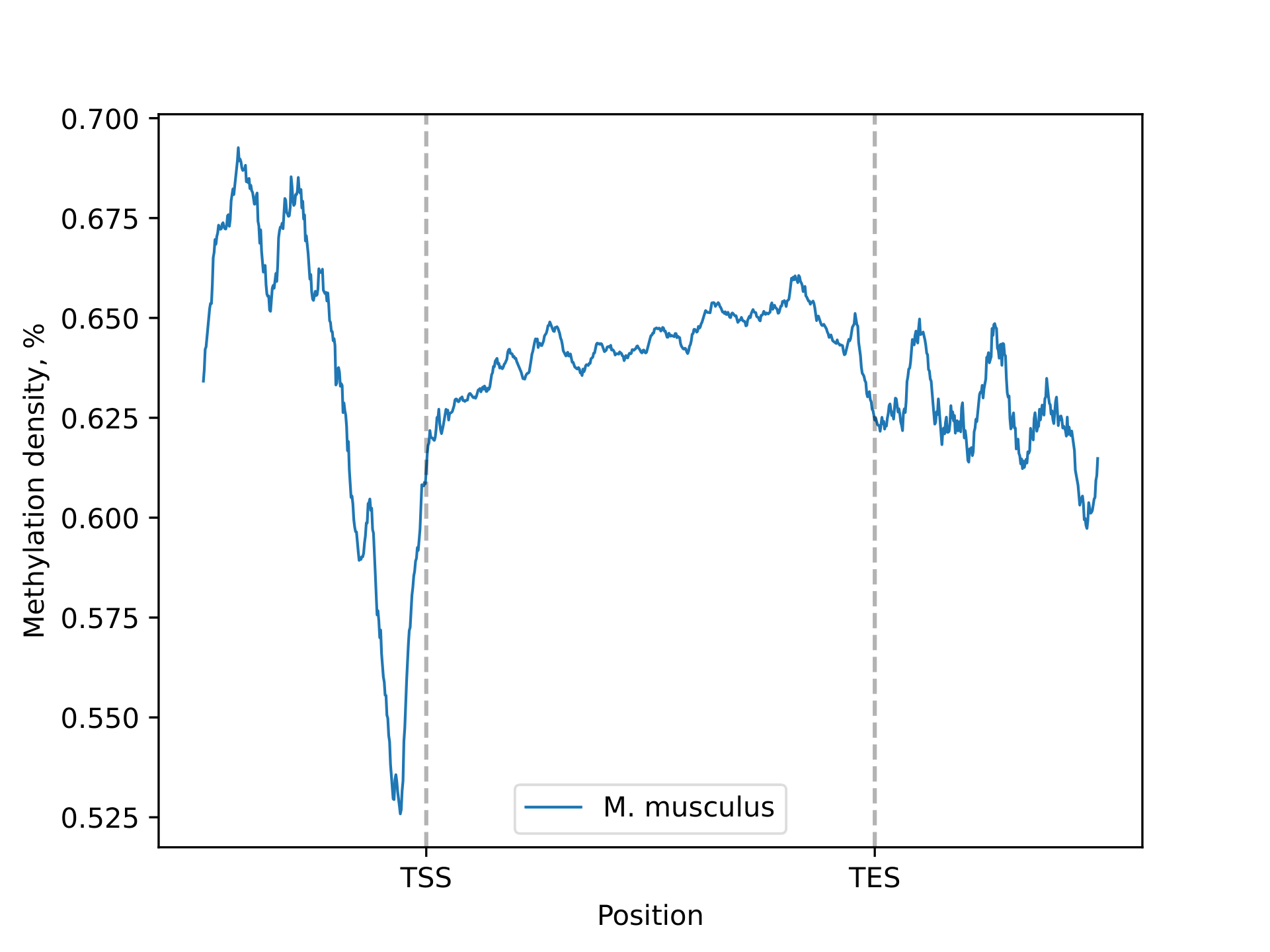
Multiple samples, same specie
# We can initialize genome like in previous example
filenames = ["report1.txt", "report2.txt", "report3.txt", "report4.txt"]
metagenes = bismarkplot.MetageneFiles.from_list(filenames, labels = ["1", "2", "3", "4"], ...) # rest of params from previous example
# Our metagenes contains all methylation contexts and both strands, so we need to filter it (as in dplyr)
filtered = metagenes.filter(context = "CG", strand = "+")
# Now we can draw line-plot or heatmap like in previous example, or plot distribution statistics as shown below
trimmed = filtered.trim_flank() # we want to analyze only gene bodies
trimmed.box_plot(showfliers=False).savefig(...)
trimmed.violin_plot().savefig(...)
# If data is technical replicates we can merge them into single DataFrame and analyze as one
merged = filtered.merge()
Output for Brachypodium distachyon:



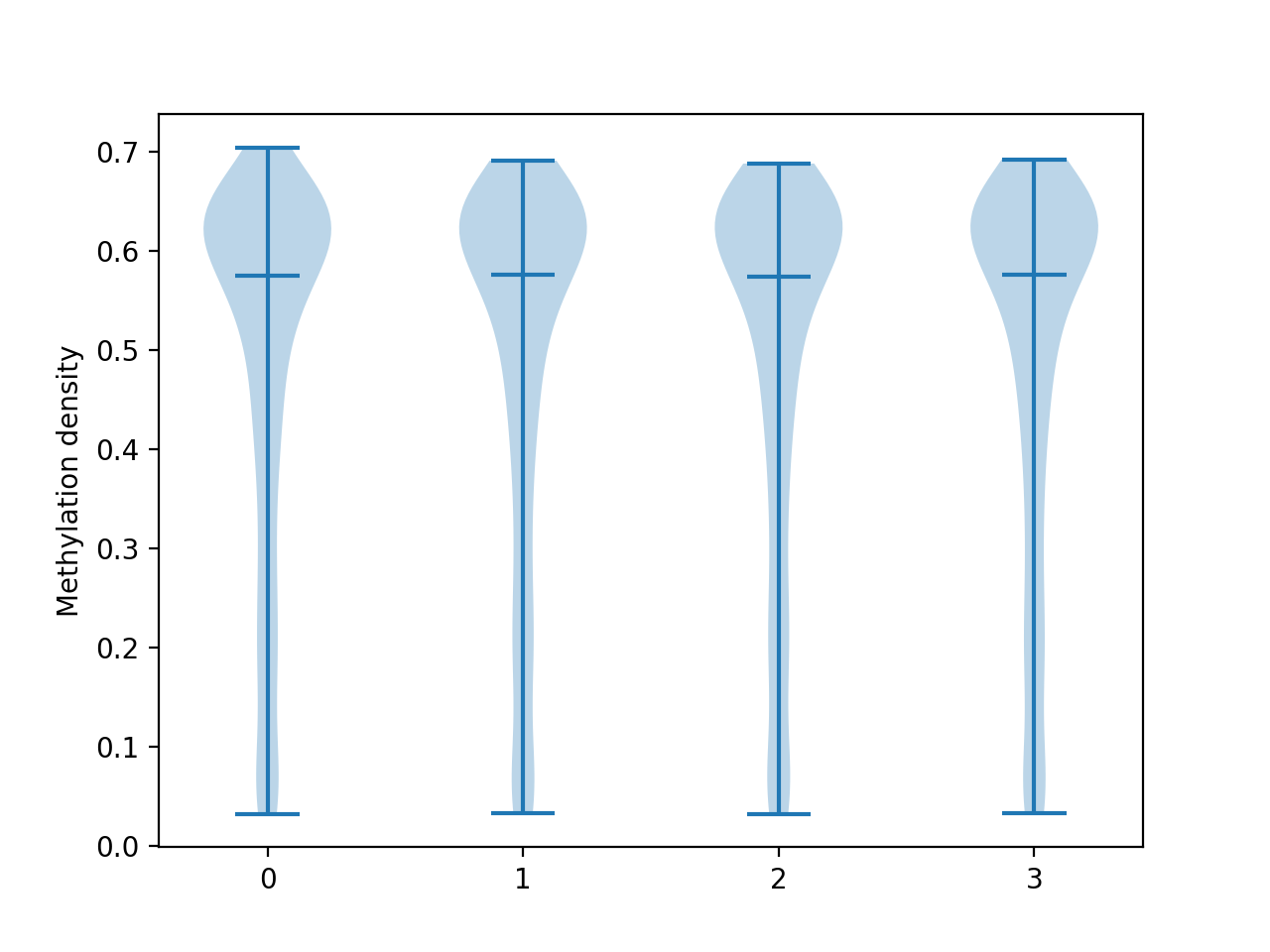
Multiple samples, multiple species
# For analyzing samples with different reference genomes, we need to initialize several genomes instances
genome_filenames = ["arabidopsis.gff", "brachypodium.gff", "cucumis.gff", "mus.gff"]
reports_filenames = ["arabidopsis.txt", "brachypodium.txt", "cucumis.txt", "mus.txt"]
genomes = [
bismarkplot.Genome.from_gff(file).gene_body(...) for file in genome_filenames
]
# Now we read reports
metagenes = []
for report, genome in zip(reports_filenames, genomes):
metagene = bismarkplot.Metagene(report, genome = genome, ...)
metagenes.append(metagene)
# Initialize MetageneFiles
labels = ["A. thaliana", "B. distachyon", "C. sativus", "M. musculus"]
metagenes = Bismarkplot.MetageneFiles(metagenes, labels)
# Now we can plot them like in previous example
Output:
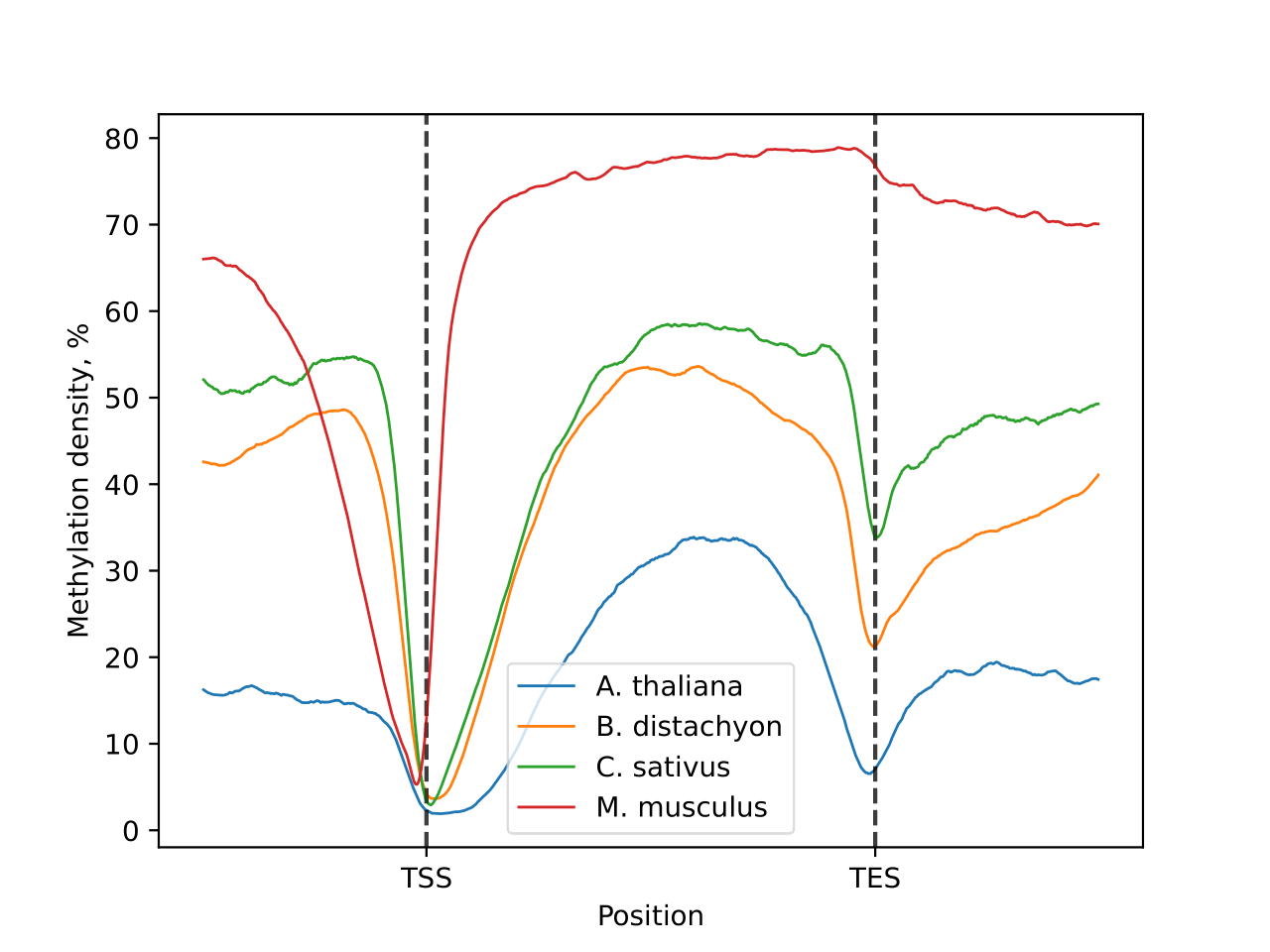
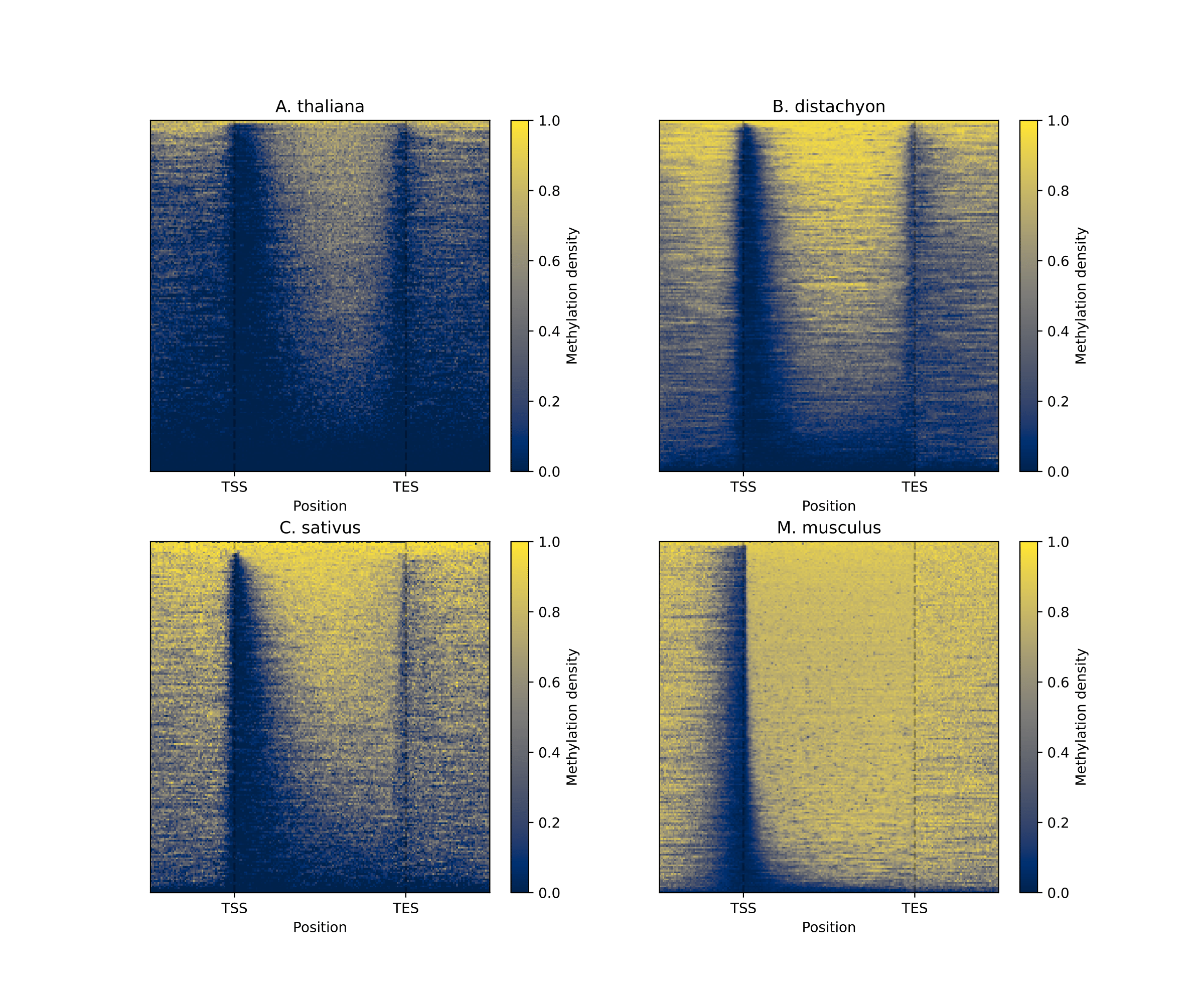

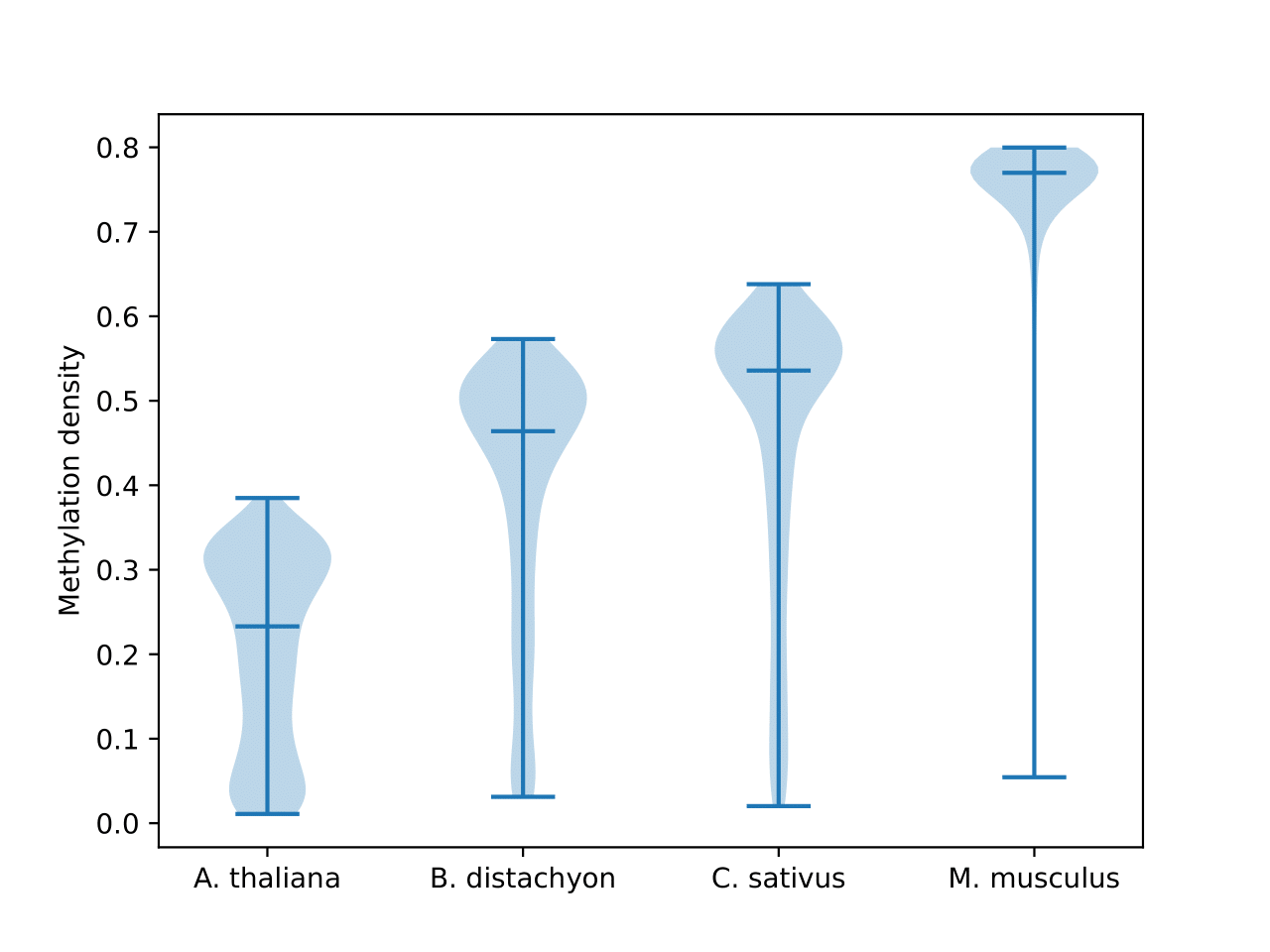
Different regions
Other genomic regions from .gff can be analyzed too with .exon or .near_tss/.near_tes option for bismarkplot.Genome
exons = [
bismarkplot.Genome.from_gff(file).exon(min_length=100) for file in genome_filenames
]
metagenes = []
for report, exon in zip(reports_filenames, exons):
metagene = bismarkplot.Metagene(report, genome = exon,
upstream_windows = 0, # !!!
downstream_windows = 0, # !!!
...)
metagenes.append(metagene)
# OR
tss = [
bismarkplot.Genome.from_gff(file).near_tss(min_length = 2000, flank_length = 2000) for file in genome_filenames
]
metagenes = []
for report, t in zip(reports_filenames, tss):
metagene = bismarkplot.Metagene(report, genome = t,
upstream_windows = 1000,# same number of windows
gene_windows = 1000, # same number of windows
downstream_windows = 0, # !!!
...)
metagenes.append(metagene)
Exon output:
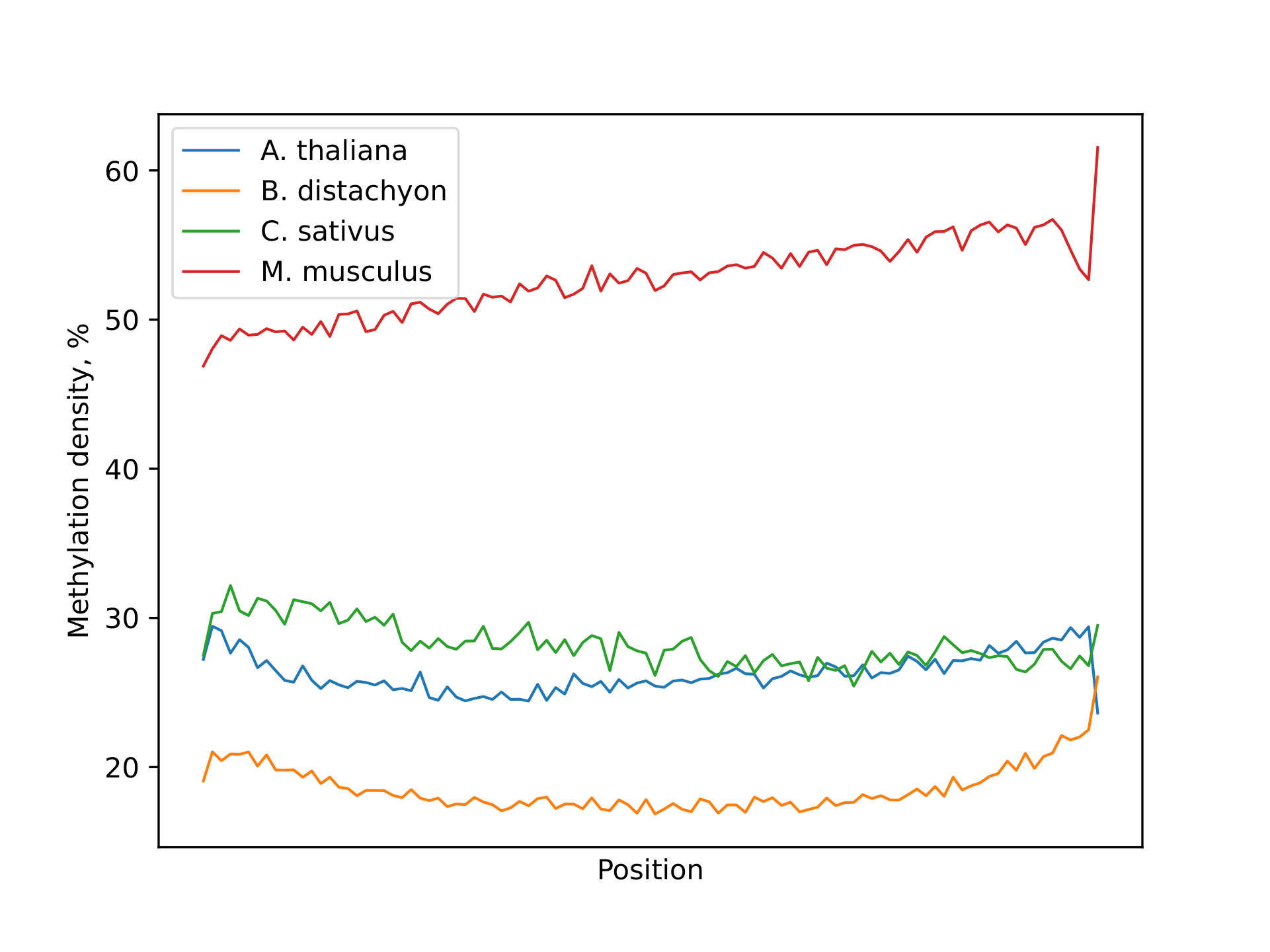
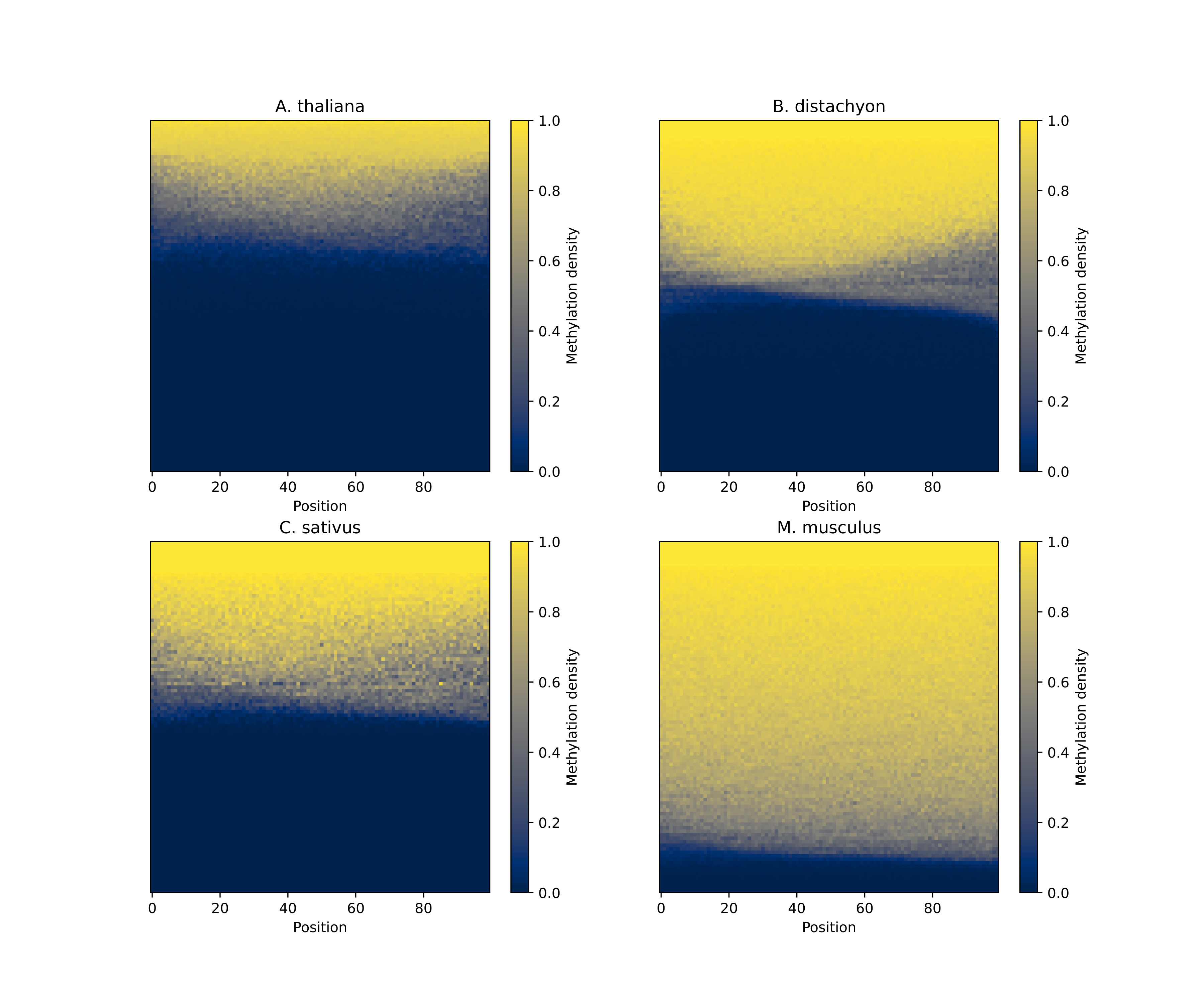
TSS output:

Chromosome levels
BismarkPlot allows user to visualize chromosome methylation levels across full genome
import bismarkplot
chr = bismarkplot.ChrLevels.from_file(
"path/to/CX_report.txt",
window_length=10**5, # window length in bp
batch_size=10**7,
chr_min_length = 10**6, # minimum chr length in bp
)
fig, axes = plt.subplots()
for context in ["CG", "CHG", "CHH"]:
chr.filter(strand="+", context=context).draw(
(fig, axes), # to plot contexts on same axes
smooth=10, # window number for smoothing
label=context # labels for lines
)
fig.savefig(f"chrom.pdf", dpi = 200)
Output for Arabidopsis thaliana:
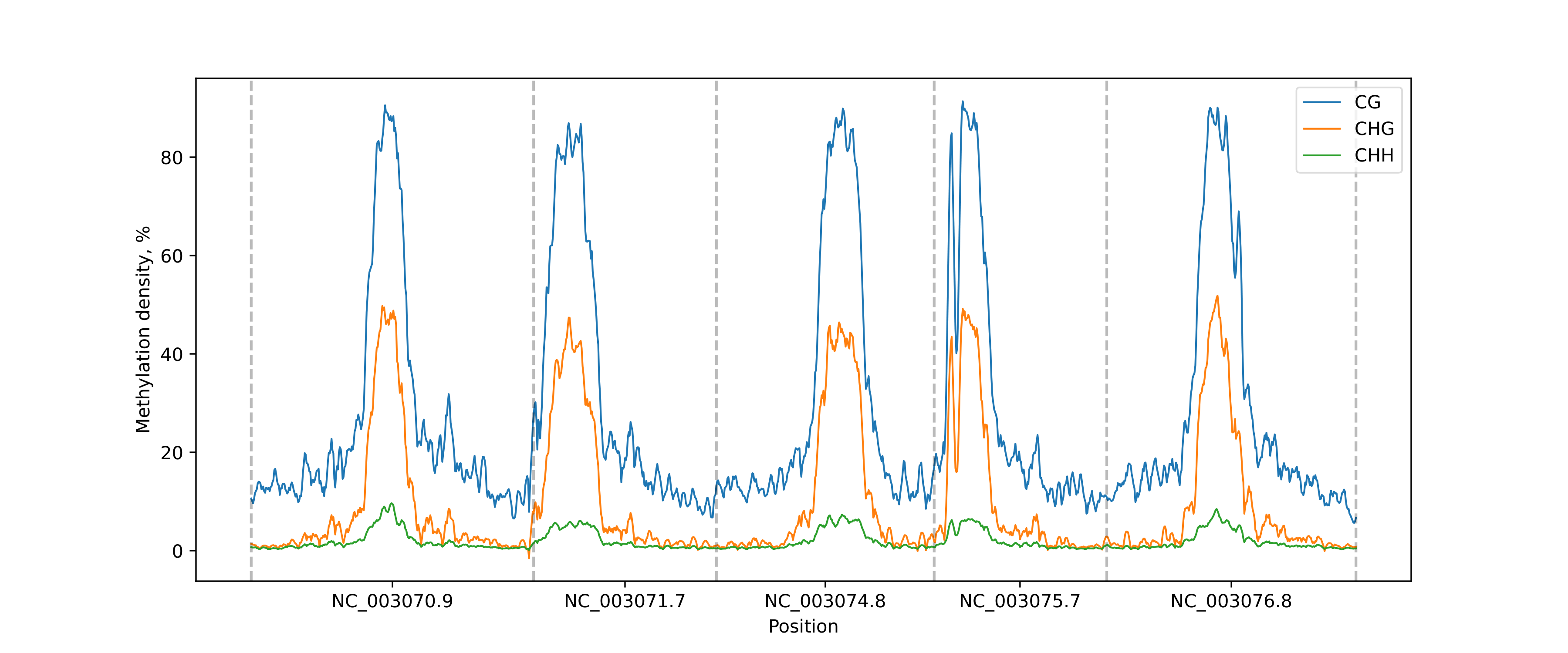
Output for Brachypodium distachyon:
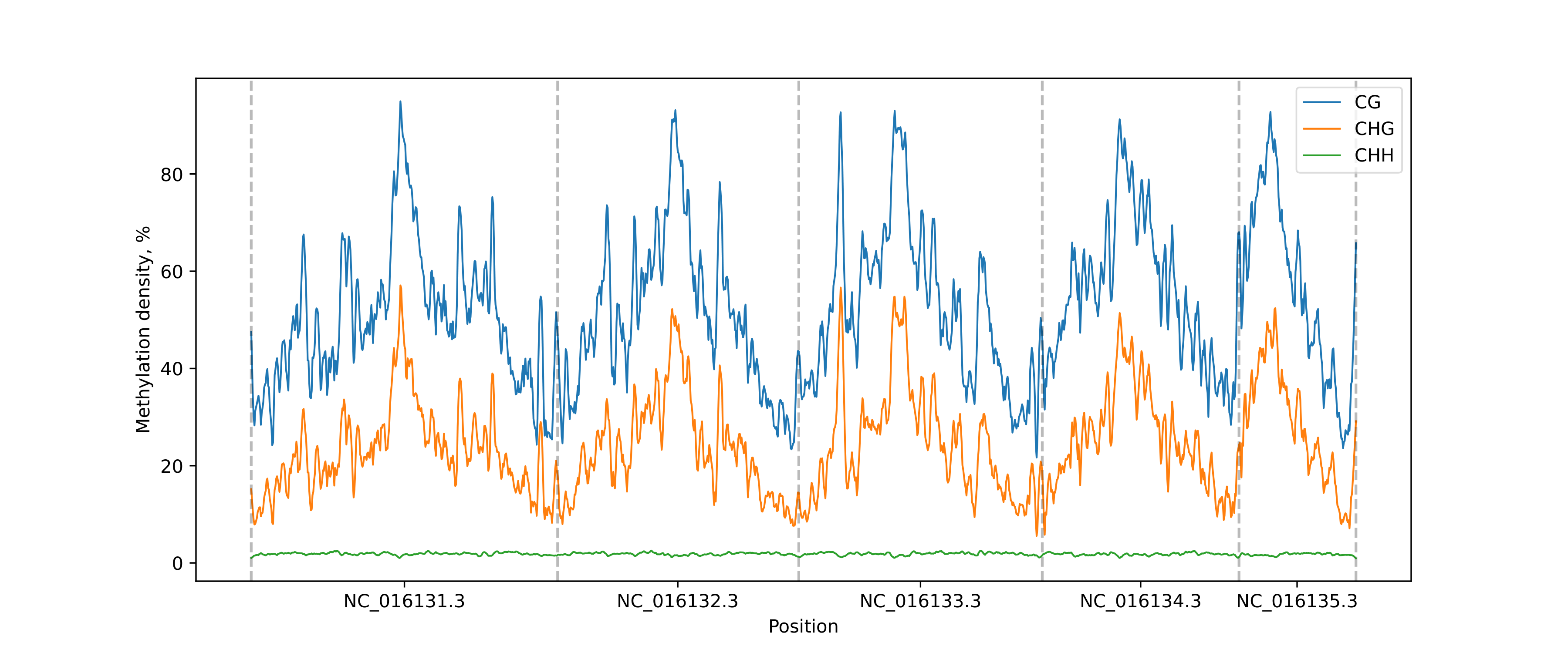
Project details
Release history Release notifications | RSS feed
Download files
Download the file for your platform. If you're not sure which to choose, learn more about installing packages.
Source Distribution
Built Distribution
Hashes for bismarkplot-1.3.2.post3-py3-none-any.whl
| Algorithm | Hash digest | |
|---|---|---|
| SHA256 | 56855b397cf44a2e0428a57f35c4d73877a1862ffc9886357bcbc001e98bdb9f |
|
| MD5 | c08c4783bc86cf12519e36bbc7b95f59 |
|
| BLAKE2b-256 | 89a9c8259ac80d19d0cace722963736f4e444f9fff681411201d44f97f22d734 |











